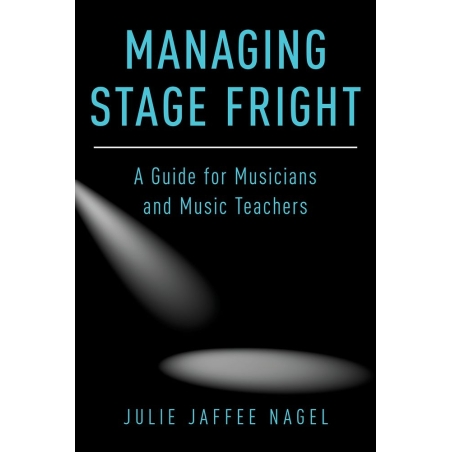Managing Stage Fright: A Guide for Musicians and Music Teachers is a practical and enlightening guide to overcoming one of the most common and debilitating psychological phenomena experienced by performers. Musician, psychologist, and psychoanalyst Julie Jaffee Nagel delves deep into the causes of stage fright, and provides actionable coping strategies for musicians and music teachers that help build self-esteem and increase comfort in the glare of the spotlight.
CONTENTS
Figures
Preface
Acknowledgments
CHAPTER 1 - STAGE FRIGHT: WHAT IS IT?
Questions for Thought
Some General Considerations About Stage Fright
A Personal Reflection
Music Teachers as Mental Health Resources
Paradoxical Questions and Further Thoughts About Stage Fright
Yerkes-Dodson Law (Arc of Anxiety)
Mental Preparation: Attitudes and Aptitudes
Talking and Listening to Students: Validating Feelings
Implications for Music Teachers
CHAPTER 2 - DELVING DEEPER INTO STAGE FRIGHT
Questions for Thought
Stage Fright: A Mind/Body Duet
Symptoms of Performance Anxiety
Discussing Performance Anxiety In Studio Class
Identifying Performance Anxiety Symptoms
Symptoms Chart
Two Activities
1-Mood Ring
2-Chill Out: Tools for Cool Students
Implications for Music Teachers
CHAPTER 3 - THE A B Cs OF STAGE FRIGHT
Questions for Thought
An A B C Model of Anxiety
Recap: A B C Model
Vignette: John
Actions for Teachers and Students
Activity 1-Identifying Letter B Responses
Activity 2-Letter B Cards (Supportive Self-Statements)
Examples of Supportive Self-Statements
Implications for Teachers
CHAPTER 4 - SYMPTOMS VS. MANAGEMENT
Questions for Thought
Symptoms as Cues and Clues
Vignette: Cindy
Assessing Thoughts and Feelings
Talking About Stressors
Implications for Teachers
CHAPTER 5 - CONFLICT - A PARADOX
Questions for Thought
Paradox: Identifying Emotional Conflicts
Recognizing Conflicts
Dealing with Memory Slips and Technique Meltdowns
Jam Plan
Some Childhood Antecedents of Stage Fright
Additional Examples of Conflict
Vignette: Robert
Young Children (and Adults) Fill the Gaps
Additional Considerations About Conflict
Conflict Chart
Symptoms Chart
Implications for Teachers
CHAPTER 6 - THE EMOTIONAL FUEL BEHIND STAGE FRIGHT
Questions for Thought
Psychodynamic Model
Why Consider Psychodynamic Models of the Mind?
Mental Ghosts Haunting the Teaching Studio
The Mind Does Not Forget: the Unconscious
A Visual Model of the Unconscious
Figure 1 - Conceptual Diagram of the Unconscious
Revisiting Cindy
Transference
Shame
Countertransference
Multiple Function
Vignette: Joe
Psychological and Practical Tips
Imagine This.....
Implications for Teachers
CHAPTER 7 - DEFENDING AGAINST ANXIETY
Questions for Thought
Performance as a Danger Situation: Ego Defenses
The Ego and Its Defenses Against Anxiety
Table 1 - Typical Ego Defenses
Vignette: Mary
Table 2:Performance Anxiety Symptoms as Ego Defenses
(Letter B)
A B C Model of Anxiety
Activity 1 - Recognizing Anxiety
Activity 2 - Relabeling Anxiety
Vignette: Cindy's Cold Hands as Ego Defenses
Shame Masquerading as Resistance to Performance Anxiety
Shame on You!
A Fusion of Musical and Personal Identity
Helping Students Discover Their Ego Defenses
Implications for Teachers
CHAPTER 8 - LEARNING THEORY AND BEHAVIOR MODIFICATION
Questions for Thought
Learning Theories as Guidelines for Teachers
Classical Conditioning
Operant Conditioning
Implications for Teachers
CHAPTER 9 - COGNITIVE BEHVIOR THERAPY, RATIONAL EMOTIVE THERAPY, AND LETTER B
Questions for Teachers
What Is Cognitive Behavior Therapy (CBT)?
An Example of Cognitive Relabeling Stage Fright Responses
Two Activities With A B C Model
Activity 1 - A B C Recognizing Anxiety Responses
Activity 2 - Rethinking and Relabeling Anxiety Responses
Neuropsychology and Brain Imagining
Beta Blockers and Performance Anxiety
Evidence-Based Claims for Reducing Performance Anxiety
Implications for Teachers
CHAPTER 10 - PERFORMANCE ANXIETY BEGINS IN THE NURSERY
Questions for Thought
Teachers As New Parents: Developmental Issues
Human Development and Performance Anxiety
Elaboration of Erikson's Eight Stages in the Life Cycle
Stage One: Trust vs. Mistrust
Implications for Teachers
Stage Two: Autonomy vs. Shame and Doubt
Implications for Teachers
Stage Three: Initiative vs. Guilt and
Stage Four: Industry vs. Inferiority
Anxiety Alerts for Teachers!!!!!
Young Children
Middle School-Aged Children
Implications for Teachers
Stage Five: Identity vs. Identity Confusion
Anxiety Alerts for Teachers!!!!
Adolescents
Implications for Teachers
Stage Six: Intimacy vs. Isolation
Implications for Teachers
Stage Seven: Generativity vs. Stagnation
Implications for Teachers
Stage Eight: Integrity vs. Despair
Implications for Teachers
Recap: Developmental Stages and Stage Fright
Additional Implications for Teachers
CHAPTER 11 - A VIRTUAL RECITAL: A SYNTHESIS
Questions for Thought
Susan: How to Understand and Handle Performance Anxiety
Concepts for the Teacher to Convey to Susan, The Recitalist
Plan for Teacher
Format of Virtual Recital
The Recital
Implications for Teacher and Recitalist
CHAPTER 12 - RECAPITULATION AND FINALE
Questions for Thought
Putting it All Together
Performance Anxiety is More Than Symptoms
Stigmas, Caution, and Optimism
Tuning In To Students and Tune Ups for Teachers
Interdisciplinary Collaboration
Criteria for Making A Referral for Professional Help
Music School Curriculum
Coda: Summary of Implications for Recognizing and Teaching Anxiety Reduction
Uniqueness of Music Teacher's Role
CHAPTER 13 - DA CAPO: BACK TO THE BEGINNING
GLOSSARY OF PSYCHOLOGICAL TERMS USED IN THE TEXT
ILLUSTRATIVE READINGS ON PERFORMANCE ANXIETY
INDEX


